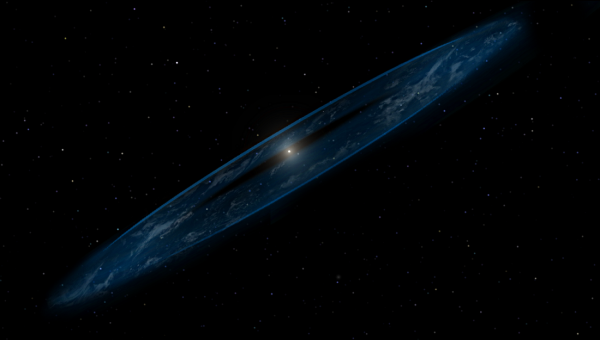BY LETTER
Niven Clouds (Smoke Rings)
Technology > Application > Infrastructure
Technology > Application > Megascale Engineering
Technology > Technology Levels > Ultratech
Technology > Application > Megascale Engineering
Technology > Technology Levels > Ultratech
Circumstellar freefall environments | |
 Image from Steve Bowers | |
| The Niven Cloud at Huan Gao in the Utopia Sphere completely surrounds its star at a mean distance of 150 million kilometers | |
Smoke Rings are microgravity environments which entirely encircle a star. They generally contain a breathable oxygen atmosphere, which is prevented from escaping by one of three methods; a thin composite membrane, a layer of airwall utility fog, or by gravity shepherding.
The first freefall environment totally encircling its local star was built in 3887 at Hip 84521, a small red dwarf star near Ras Alhague in Mutual Progress space; this structure (known as Rolf's Donut) was a toroidal balloon with a standard freesphere membrane to retain the atmosphere. The torus was 10,000,000km in diameter and completely filled its orbital path, resulting in a length of just under 32,000,000km. The smaller diameter of the torus was only 600km. Freesphere membranes have many features in common with worldhouse roofs, as they are self healing and incorporate magshield arrays to protect against charged particles in the solar wind, but (unlike worldhouse roofs) are pierced at regular intervals (generally along the midline) by spacecraft docking ports. Additionally, whereas a worldhouse roof is a patchwork of multilayered gas cells, a typical freesphere "membrane" consists of a sandwich with a 5-10m thick middle layer of water for radiation shielding.
After the Version war several larger tori were built, in the Keter Dominion, MPA, Utopia Sphere and elsewhere, but the larger tori were shown to spontaneously develop regions of different atmospheric density. This led to the development of actively maintained open rings, known as Smoke Rings or Niven Clouds. The first of these, Huan Gao, was built in the Utopia Sphere in 7781.
The modern Niven cloud is a gas torus encircling a star which may be used as a habitat for those wishing to live in a megascale free fall environment. Its minor radius (the distance between its core and its outer envelope) is about(~)500,000km but only the core, ~1,000km in diameter, has a atmospheric pressure high enough to be inhabitable by baselines. However nearbaselines may venture farther out and the outer portions of a Niven cloud may be livable to those with low pressure augments as well as vacuum tweaks, vecs, etc. The non-core region may even have a larger population than the core but otherwise consists of only thin gas and multiple layers of specialized airwall foglets. These foglets are free-flyers and use swarm intelligence to coordinate their efforts to redirect air molecules back toward the core, thus containing the atmosphere. The foglets use small light sails (among other methods) to position themselves. These light sails may be used to redirect sunlight in towards the core from all sides and with a projected area ~1,000,000km wide they can collect (or block) enough light to make the niven cloud habitable over a wide range of distances from its star. However when the foglets are programmed to redirect and block light in a cycle for day and night a niven cloud normally has a major radius (the distance between the core and its star) of ~150,000,000km when surrounding a G-type star.
A very few smokerings have been constructed using gravitic shepherding, relying on hyperdense masses or other forms of metric engineering to maintain the shape of the ring. These rings require godtech for maintenance and are only found in systems under archailect rule.
 Image from Steve Bowers | |
| Most sophonts and animal life that inhabit a smoke ring use wings, fins or flippers to move from place to place and for orientation. Here an adapted human shepherds two tetrafish, which use air jets for propulsion. In the distance are some asterisk trees, which slowly rotate in the steady orbital winds. | |
The 'open' architecture of a Niven cloud connects it to the rest of the star system in a way that can not be had with other habitats. If there are any other habitats in the same system as a Niven cloud they may be made to pass through the thin gas of the cloud's outer envelope during their orbits to effect a transfer of inhabitants. In such cases the habs use light sails and/or mag sails to regain orbital speed lost to friction with the gas. Dyson trees are a popular hab choice in such systems as they can further extend the already vast ecology of the Niven cloud out to the rest of the star system and a cloud/orwood combination can mature into a green dyson. In passing through the Niven cloud's outer envelope these trees can exchange pollen and/or symbiotic life-forms with the cloud and thus with each other.
In some cases it is the orwoods themselves that give rise to the torus of gas, sometimes by design and sometimes by accident as the comet bodies outgas and mesobots from the trees' utility fog break loose. Over time the foglets and gases collect in a common orbit as a 'smoky ring' which is, more often than not, too thin to support lifeforms without vacuum-adaptations. It takes a replacement of the simple airwall foglets used around orwoods with the more advanced, light sailed, free-flyer foglets for a smoke ring to become an inhabitable Niven cloud.
Related Articles
Appears in Topics
Development Notes
Text by AI Vin and Steve Bowers
Initially published on 10 January 2006.
Initially published on 10 January 2006.






